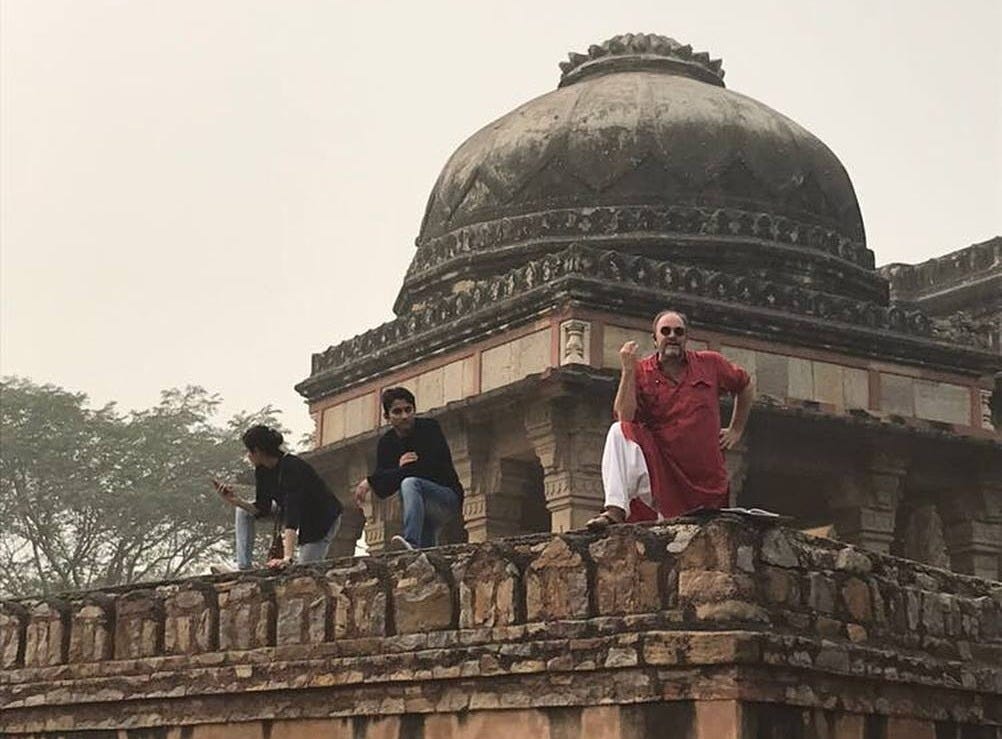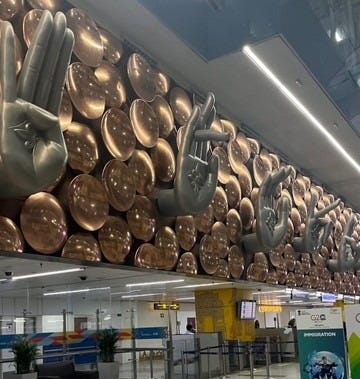New Delhi, India
History, Heat, Hustle, Heart, Home
I was born and raised in Delhi — spent about 22 years there. And sure, I probably know more about Delhi than most people — but still less than the man - William Dalrymple. A British historian, writer, and broadcaster. I have learned more about my own city through his work. The City of Djinns, The Last Mughal, and Princes and Painters in Mughal Delhi — all of which explore Delhi’s layers of history, identity, and charm (+ve contribution in building the ‘history’ of India by a British man, unusual yes)
I met Dalrymple on one of his history walks in Delhi — yes, he occasionally does those! Agencies like DelhiByFoot/Delhi Heritage organise these and I would highly recommend trying them. On this city tour I remember walking the stretch between two well known spots in Delhi - Tughlaqabad and Nizamuddin — places I’d known of separately, but had never quite connected until Dalrymple brought them together through his storytelling
So the story goes back to the 1300s, when Delhi was ruled by a Sultan from the Tughlaq dynasty. The Sultan was building a grand fort and had ordered all laborers to work exclusively on his project. Meanwhile, not too far away, a Sufi saint, Nizamuddin Auliya, was constructing a public stepwell for the community. The Sultan, furious that workers were secretly helping the saint at night, threatened punishment once he returned from a military campaign. In response, the saint is said to have remarked, “Hunooz Dilli door ast” — “Delhi is still far away.” Ironically, the Sultan died in an accident before ever making it back to Delhi!
"Dilli door Ast" (Delhi is still far away)
Locals interpret the story in different ways — some see it as a tale of saintly triumph over the Sultan’s ego, others blame the saint’s curse for changing the political course - I am not sure which side I am on. All I take away is what I see today- the Sultan’s fort - called Tughlaqabad in Delhi is now mostly haunted stone (‘haunted tours’ are organised here), while the saint’s courtyard (called Nizamuddin Dargah) is filled with devotees coming to offer flowers, and hosting soulful sufi music nights every weekend. I’d recommend seeing both, for both the Sultan and the Saint (I also mean literally, their respective graves are located in the fort and near the stepwell)
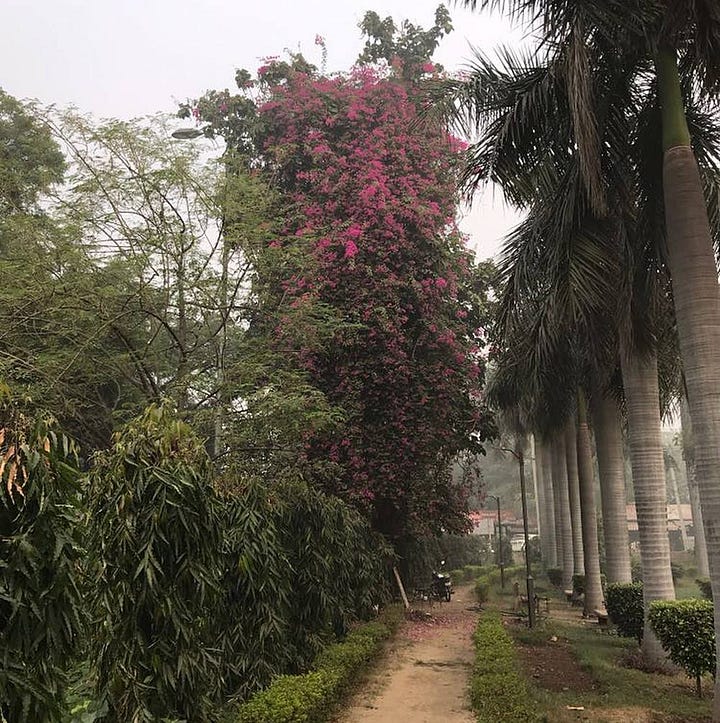

Delhi is the OG capital city. It’s been wearing the crown for centuries — literally
Back in the 1100s, Delhi was chosen as the capital under the Sultanate rule. In the 1500s, the Mughals took over, but Delhi kept its capital status. Fast forward to the 1800s, when the British rolled in cementing Delhi as the imperial capital yet again. And the same stayed since post Indian independence
You can trace Delhi’s evolution in its stones that still stand today throughout the city. The Sultanate dynasty built the Qutub Minar with its red sandstone and Arabic carvings that reflects the early Islamic architecture and influence in India. The Mughal monuments in Delhi — the Red Fort and Jama Masjid have marble inlays (think era of the Taj Mahal). Then came Lutyens' Delhi under the British with cream sandstone and sweeping boulevards which is pretty much all of central Delhi today
Post-independence, the architecture didn’t change much, but the names and narratives did. Rajpath (meaning path of the British) was renamed Kartavya Path (Path of deeds), King George’s statue was replaced with the Amar Jawan Jyoti (commemorative flame for war veterans) in India Gate. These changes did strip away colonial symbolism — but intentionally or not, most of the original structures were left intact. Which means: you can still walk through Delhi and see, in its buildings, a living timeline of politics
In the line of iconic architecture/residences in the city, I would personally add two more rather modern additions; The Lodhi hotel (formerly owned and designed by AMAN group) - featuring artwork on the walls depicting the monuments which you can also admire from the direct views just outside the windows! And The Roseate — minimalist, serene, and surprisingly peaceful for a hotel within the city, successfully managing to tune out all noise/ chaos
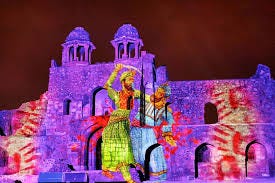

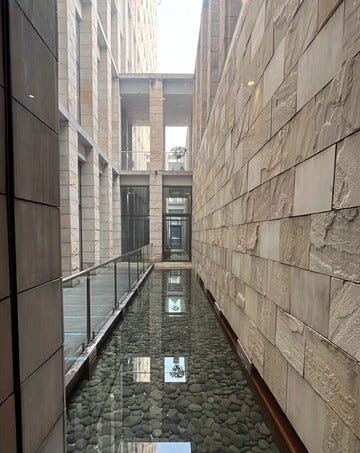
British Council, and American hand me downs as gateway to global culture
When my two siblings and I were kids — and my mom was juggling work — she’d often drop us off at the British Council Library in Delhi. It was there that I first stumbled upon two British-Indian authors: Rudyard Kipling and Ruskin Bond. Ruskin Bond’s ghost stories were an instant hit in our little sibling circle. We’d read them, get scared, and then beg to sleep in our mom’s room at night. Kipling’s The Jungle Book (recall Mowgli?) I remember performing in school plays. To me, these authors and their perspectives were the first bridge between India and some idea of “the world out there.”
Like many Indian families, we had cousins or relatives who had moved to the US or UK in the 1970s. Many would visit or send hand-me-downs that felt like treasures: an iPod, a Game Boy, or in my case, a virtual pet
It was through that iPod that I discovered Britney Spears and Avril Lavigne (still on my playlist, no shame), through the Game Boy that my brother and I logged hours on Pokémon, and through that virtual pet that I got my first (very unreliable) taste of responsibility. These tiny glimpses into British and American pop culture stitched together a larger idea — one many Indian kids of the '90s and early 2000s might relate to: the glamour of the West. Moving abroad wasn't just a move; it came to be seen as an aspiration whispered across dinner tables, school corridors, and wedding gatherings
Fast forward a decade — I’ve lived abroad including in both the UK and the US for over ten years now. And? That starry-eyed aspiration has faded naturally, been there, done that. I also look at Delhi and find it to be like most global cities today now — at least when it comes to goods, services, experiences, or aspirations. Maybe not in Air quality (air is often in despair I know), and social liberalism, gender equality et all. The first is an easy problem to solve, the second will take some more time


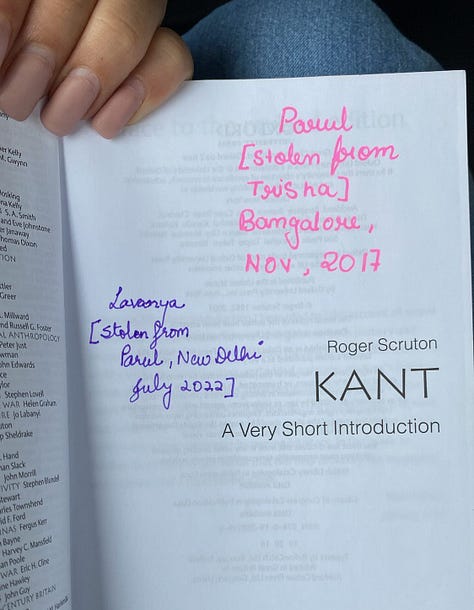
Delhi’s Service as a Service (SaaS)
This is probably true for most of India, but it’s especially in Delhi — the country’s largest city by population (#33Mn or so). Every service imaginable is available as a service, at almost any hour, and delivered with efficiency
Need a quick hair blow-dry? Walk into your local salon and be out in 15 minutes, hair bouncing. Craving a late-night snack? Can choose from hundreads of options, most available 24*7 at little to no cost delivery charges - some thanks to online portals like Blinkist, Swiggie Genie and others to just sheer presence of # of businesses. People services like house helps/nurses/salon at home services/doctors can also be accessed easily, in time and often without months in advance appointments
How has Delhi — or India in general — become this “service-as-a-service” powerhouse? It comes down to flawless execution at scale
Delivery systems have been tested, stretched, and fine-tuned daily in a city of over 33 million people. Expectations and demand is high, and competition is fierce. Resultingly, little margin for error, and ample room to iterate until perfection
Delhi feeds every appetite and budget
If you're in the mood for fine dining, there’s Dum Pukht — known for its slow-cooked Awadhi cuisine. Think: chicken simmered for 24 hours, melt-in-your-mouth kebabs, creamy dals served in silver, all crafted by chefs who’ve probably inherited recipes generations old. There is Bukhara with its 3ft long Naan, and then there’s Indian Accent — modern Indian cuisine that some call fusion and others call confusion (I'm still team fusion, especially for their take on Daulat ki Chaat)
Equally great are street-side legends — chole bhature from North Delhi, shawarma from Al-Bake in New Friends Colony, or galouti kebabs from Pandara Road. These places have been around forever and for good reason. Relatedly, people often ask me if it’s safe to eat street food in Delhi. My answer? If you grew up here, your stomach probably comes with built-in immunity. If you didn’t, stick to safer bets like Haldiram’s, or local chains like Bikanervala
And big surprise, there is something called a free lunch in life, or close to a free lunch - and it is very much available in Delhi. ₹40 or 0.5USD plate of chole-kulches or free langars at gurdwaras — community kitchens where anyone can eat together


Drinks for everyone — but no ‘cheers’?
One of the fun things I’ve picked up while traveling is learning how to say “cheers” in different languages. “Na zdorovye” in Russian, “Salute” in Italian, “Santé” in French, “L’chaim” in Hebrew, “Prost” in German — and of course, the universal “Cheers, bro” in English. But when people ask me, “What do you say in Hindi?” — I honestly have no answer. Because, well, there isn’t really a Hindi equivalent for ‘cheers’
It’s not that we don’t drink in India — far from it. But culturally, we just don’t toast that way. There’s no clink-your-glass moment with a unified phrase. Maybe it’s because alcohol wasn’t traditionally part of public dining culture, or maybe it’s just that we express celebration differently — with food? music/dance? a head nod?
That said, Delhi definitely has places worth raising a glass in, even if we don’t have the word for it. From cozy, upscale ones like Piano Man Jazz Club, or ATM in Sundarnagar with its live music and cocktails, to My Bar — legendary for its no-frills ₹100 (1-2 USD) drinks and college crowd chaos. And then, of course, there are the ‘thekas’ — Delhi’s beloved local liquor shops, where the "bar" is often your car bonnet, and the ambiance is a bunch of friends, plastic cups, and the glow of streetlights
Green but not Blue+Green
Open green spaces add a whole layer of charm to any city, and Delhi does it well — so well, in fact, that it’s ranked among the top 5 greenest cities in the country. There is Sunder Nursery or Delhi’s version of Hyde Park, Lodhi Gardens, The Mughal Gardens at Rashtrapati Bhavan that open seasonally, the Ridge in North Delhi (Delhi’s wildest green patch), and countless local parks like Deer Park in Hauz Khas, Nehru Park, and many more. Everytime I was in one of these parks I would spot either school kids on picnics, families playing frisbee or catch or walking their dogs, lovers tucked into quiet corners, or people deep engaging in yoga classes - lots of activity
Oddly though, for a city that’s got so much green, these greens tend to stay inland, while the riverbank (Yamuna river flows through the city) remains largely underdeveloped and disconnected
Maybe one day there’ll be a makeover — a Delhi version of the Seine in Paris or Thames path in London. But for now, Delhi’s greenery lives in its gardens, not along its water
University of Delhi — has two campuses — North and South — spread out on opposite ends of the city. I studied in one of the colleges in North Campus, and if you’re familiar with the Indian education system, you’ll probably already be handing me some brownie points for that. Why? Because we’re a country of 1.2 Bn, and to secure a seat in one of the top colleges, you often need to score upwards of 95% in standardized school exams
So there I was: fresh out of school, proud to have landed a spot in my dream college in North Campus. But I soon realized some of the hard part wasn’t over but had just begun! I attended classes in a small non-air-conditioned classroom with 60 other students, in 40+°C (that’s over 100°F) heat, surrounded by peeling paint and more chaos than structure. Classes were few and far between, but you were expected to keep up — and do well
Years later, I found myself at Oxford, where we were being offered “sympathy leave” to deal with the stress of the pandemic — including the option to skip exams entirely. For me, the answer was easy - I did not need leave and wanted to take the exams. Indian Universities prepare you for everything — you just learn to show up, even when it’s hard, or fewer things seem hard
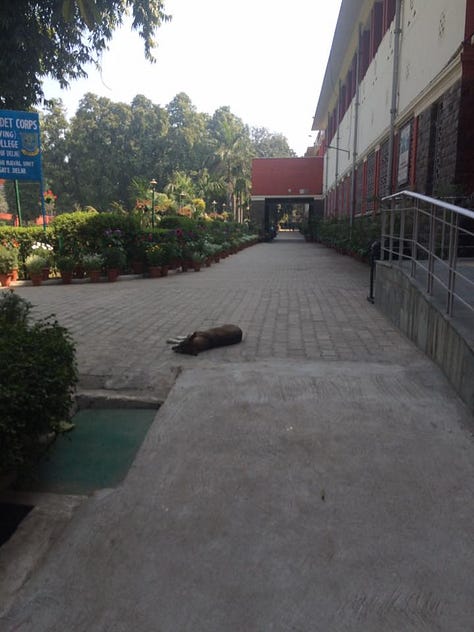
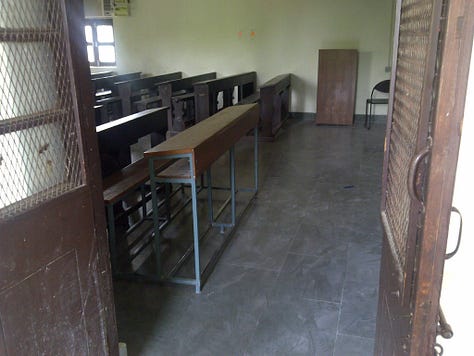
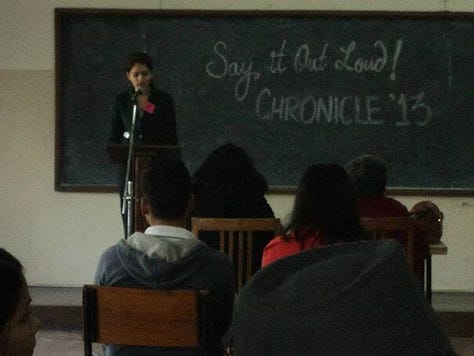
Delhi comes in a ‘unit’. I still remember what I saw during the early days of Covid-19, when I was back home in Delhi. People were sharing oxygen cylinders with strangers, risking their own safety to drive across the city and deliver supplies, and setting up volunteer groups to coordinate help for entire neighborhoods
It’s something deeper about the city or even the country’s collective culture— the idea that survival isn’t individual; it’s always about the unit
And Delhi is exactly that kind of city—it is always about the unit. And there are many units, the ‘school units’ is a common one, birds of a feather (read select schools, Modern School namely) flock together. ‘Locality units’- people in one locality who get together and host events, festival parties (Diwali- read ‘card parties’, Holi- water colour festival), and ofcourse the ‘family units’ which includes immediate family and cousins and cousins of cousins and the lot. These units are tight knit and often closed communities
So for any outsider, like my international friends looking to move to Delhi, or considering going on solo trips and looking to simply meet people like they would in other cosmopolitan cities like London/NY/Paris - I always warn them, you have to find your way into an existing unit. Delhi doesn’t always open its arms easily, but once it does, you’re in — in a very warm and fun-loving community
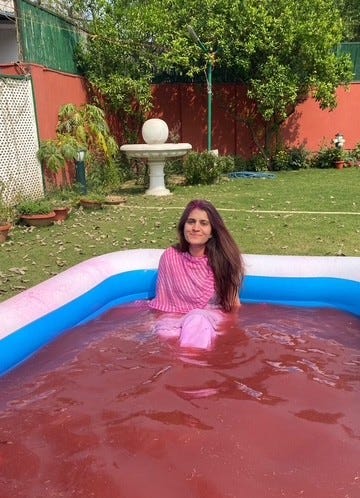
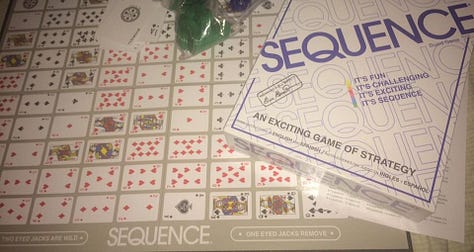
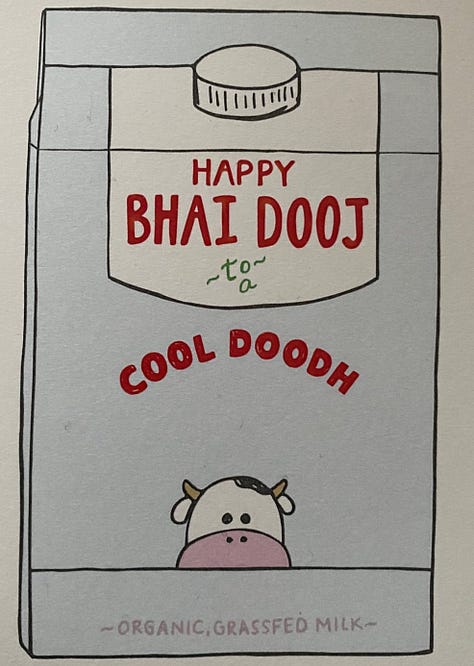
Buying in Delhi? Delhi may not have an indigenous craft tradition of its own, as it’s a city shaped by immigrants from across India — But that very diversity makes it a magnet for top artisans, designers, and craftspeople from every corner of the country
Their work is showcased all over the city—from curated garment collections at Ogaan and Pernia’s Pop-Up in Mehrauli, to custom fashion creations in Shahpur Jaat, denim treasures at Mohan Singh Place, wholesale fabric stores in Chandni Chowk, bulk supplies from Sadar Bazar, and flower shopping at the local mandis. These are the many pockets - and then for a one-stop cultural and shopping experience, there’s Dilli Haat, a craft village featuring artists and cuisines from every state in India
Care & Chaos
Every time I land in a new city, the airport gives me a little preview of what I’m in for. In the U.S., before I even leave the arrivals hall, I’ve already spent $5 on a luggage trolley—hello capitalism. In Eswatini its the three portraits: King Mswati III, the Queen Mother, and the Prime Minister, reminder of the spirit of the nation, or in Nepal, a separate VIP line at immigration for ‘Indians’ telling of the valued status Indians have…
In New Delhi, I’m greeted by a sea of people waiting at immigration line (note at all times, 2am at night or 2pm in the afternoon) and an artwork on the walls depicting a pair of folded hands —basically the perfect summary of the city; warm hospitality and a crowd of chaos. Which is exactly how my every trip to Delhi has been, is, and likely will always be - and very likely it will be the way for you
Concluding reflection: Delhi is home to around 25Mn people, and when you include the wider National Capital Region (NCR) — think of it like DMV to DC, Zone 20 to Paris, or Brooklyn to NYC — the number jumps to nearly 33 million. So yes, be prepared to be overwhelmed at the sight of lots of people— most, if not all, are well intentioned, and will live and let live. Maybe occasionally try to sell you things/services? which you are very much permitted to negotiate on/haggle/or politely decline interest. Yes it can be chaotic, but its functional chaos with its own unique charm

